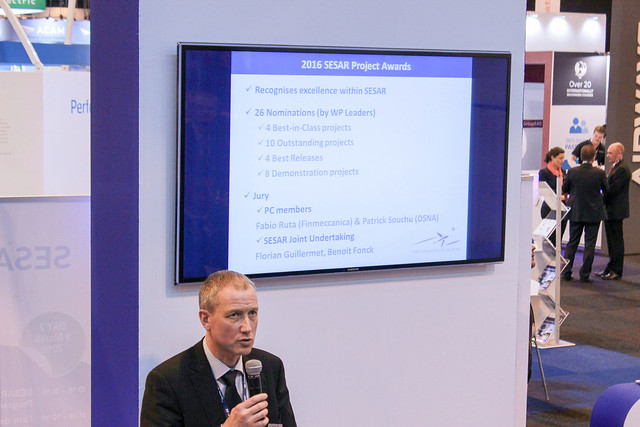Projects focussing on system-wide information sharing, enhanced airport arrivals and flight efficiency procedures, and the compatibility between SESAR Solutions have received prizes in this year’s SESAR Project Awards. The winners were announced on 8 March 2016 at the World ATM Congress in Madrid, during a ceremony presided over by Florian Guillermet, Executive Director of the SESAR Joint Undertaking, and Benoit Fonck, SJU Chief of Development and Delivery.
The awards were created in order to recognise excellence in research and innovation (R&I) within SESAR and to pay tribute to the hard work and commitment of the members and partners involved. A total of 26 projects were submitted for nomination in several categories, namely 4 Best in Class, 10 Outstanding Projects and 4 Best Release Exercises, as well a new SESAR demonstrations prize category with 8 submissions. The jury was made up of Fabio Ruta and Patrick Souchu, who represented the Programme Committee, and representatives of the SJU. “The competition this year was of extremely high quality, and I would like to congratulate the winners as well as all the nominees for their outstanding dedication to delivering high-performing solutions for Europe’s ATM and aviation sectors,” said Mr Guillermet.
In the Best-in-Class category, the jury distinguished P.14.01.04 for delivering the specifications for the System-Wide information Management technical infrastructure (SWIM-TI), demonstrating the growing maturity of this key element in Europe’s ATM system. Working together with other SESAR projects, the project team produced a series of SWIM-TI technical specifications for specific types of information sharing (i.e. safety-critical, air/ground advisories), as well as a run-time registry of services and applications. These elements underpin the SWIM principle of providing the right information to the right people at the right time. The jury also highlighted the project’s high quality of work and the support provided by the project team to SWIM-enabled validation exercises and events, such as the forthcoming SWIM Global Demo. Project Manager, Antonio Strano, Finmeccanica (formerly Selex ES), who accepted the award on behalf the members of the project[1], presented some highlights of the work undertaken by the team.
Improving airport arrivals was the focus of the winning project in the Outstanding Project category. Project 10.09.02 was recognised for contributing to the delivery of a series of multiple airport arrival/departure management (AMAN/DMAN) solutions to optimise traffic delivery to more than one airport, with minimal route or time extension, and to enable a constant throughput into the en-route phase of flight. The jury singled out the innovative prototypes delivered by the project, such as those to validate extended and cross-border AMAN (E-AMAN and XMAN), integrated AMAN and DMAN and the integration of AMAN in the definition of target times of arrival in the context of trajectory management. Once again, the project demonstrated a high level of expertise as well as a commitment to work collaboratively with all operational stakeholders involved. Project Manager, Mustapha El Mizeb, Thales, who collected the award on behalf of the Thales and the other members of the project[2], presented more details about this collaborative effort as well as some of the validations in which the project was active.
In the Best Release Exercise category, the award went to P5.3 VP 805 integrated validation, demonstrating the compatibility between airborne spacing - interval management, sequencing and merging (ASPA-IM-S&M) and initial four dimension trajectory (i4D)/controlled time of arrival (CTA) operations. The exercise also validated that ASPA-IM-S&M could realistically be integrated into an E-AMAN horizon and bring added value compared to conventional procedures. The jury noted that the exercise is first of its kind, validating the interplay between several key SESAR Solutions. The complexity of the validation infrastructure was recognised, in particular the integration of the distributed validation platforms (both ground and airborne) co-located either at the validation site or connected from a remote site.
Luigi Mazzucchelli, who accepted the award on behalf of ENAV and all exercise contributors[3], provided the audience with an overview of the validation results, as well as the performance benefits that the combined solutions are expected to bring.
Finally, FAIR STREAM[4] picked up the prize in the newly-created Best Demonstration Project category, for its successful demonstration of the use of target time of arrival (TTA) instead of - or complementary to - calculated take-off time (CTOT). The project conducted over 1,000 flight trials, showing that TTA adherence can improve traffic predictability, as well as result in more efficient workload management and increased sector capacity. The jury congratulated the FAIR STREAM consortium for its indepth work and effective communications on its results. Accepting the award on behalf of DSNA and the other contributing members[5], Estelle Le Guilcher, provided the audience with an overview of the demonstration, as well as the details of iStream, a follow-up demonstration on flight efficiency procedure.
[1] P.14.01.04: Airbus, Eurocontrol, Finmeccanica (formerly Selex ES), Frequentis, Honeywell, Indra and Thales
[2] 10.09.02 project members: DSNA, ENAIRE, Indra, Natmig, Thales
[3] P5.3 VP 805: Airbus, ENAV and Finmeccanica (formerly Alenia Aermacchi and Selex ES)
[4] FABEC ANSPs and AIRlines in SESAR TRials for Enhanced Arrival Management
[5] DSNA, DFS, skyguide, Air France, SWISS, Lufthansa, Airbus Prosky. Other partners have been associated: Hop !, Delta and Boeing
Click on the picture to access the photo album

